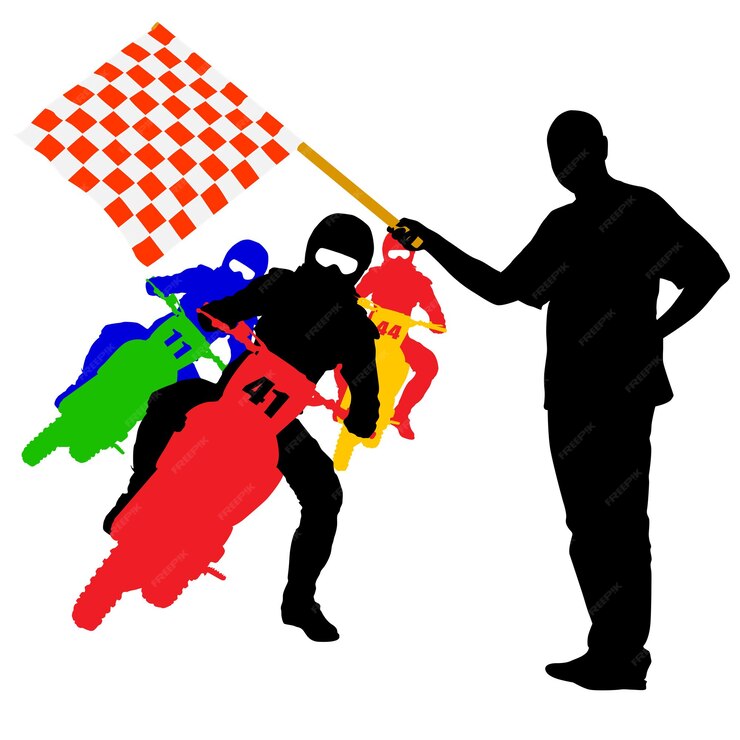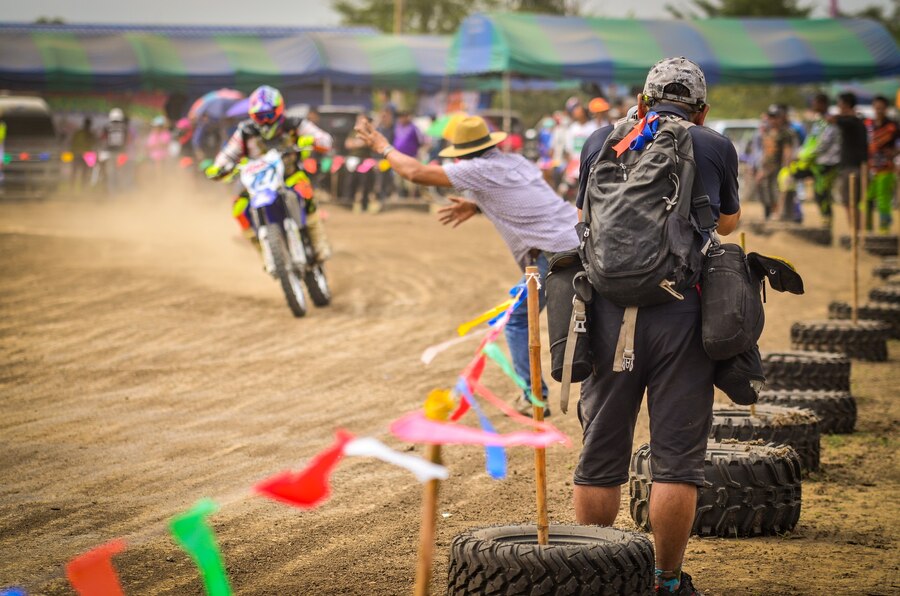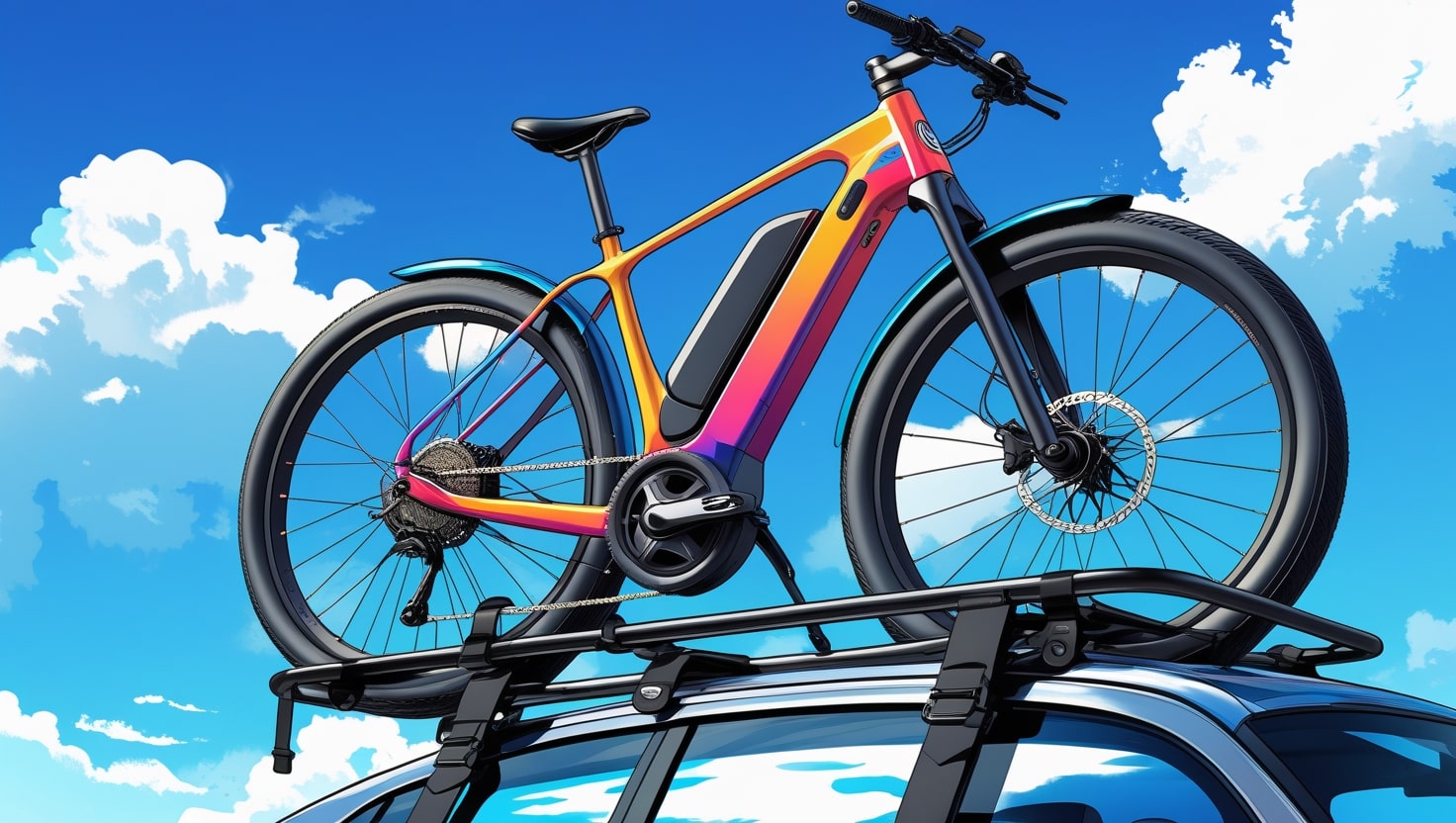Motocross racing is an adrenaline-filled high-speed sport, often compared to a Darwinian chess match, where riders must precisely navigate dirt tracks. As someone who has watched countless events, I’ve seen how beginners sometimes tackle jumps they shouldn’t, and even experienced riders can find themselves flying off their bikes. Amid the chaos of rearranging every dirt molecule, flags bring much-needed law and order to the track. These low-tech yet effective tools help maintain safety in a world where high-tech society often dominates.
Understanding the motocross flags meanings is essential for any rider. Two key governing bodies—the AMA (American Motorcyclist Association) and the FIM (Federation Internationale de Motocyclisme)—oversee these flags and their colors.
Herw Includes AMA motocross guidelines.
Related: Dirt Bike VIN Checks Made Easy
Motocross flags meanings (in alphabetical order):
Black flag: The black flag is serious and means the race has been stopped for one specific rider. A marshal will display the rider’s number on a board, signaling them to stop racing and immediately report to an official.
Blue flag: A blue flag with a diagonal yellow stripe warns a slower rider that they are about to be lapped by a faster rider. It advises the slower rider not to impede or block the pass of the faster competitor, ensuring smooth racing.
Checkered flag: The checkered flag, made of black and white, traditionally denotes the end of the race. However, it can also mark the conclusion of practice sessions, warm-ups, or any other phase of the competition. Its signals are universally recognized.
Green flag: A green flag signals the start of the race during the opening lap. Once the first lap is completed, the flag is presented again to indicate that the race is underway and everything went as planned at the starting line. Riders and spectators rely on this signal to know the event has officially begun.
- Red Cross flag: The Red Cross flag is a white flag with a red cross (both horizontal and vertical) and signals the presence of medical personnel or equipment near the track. Riders must slow down, exercise caution, and avoid jumping or passing until they are past the EMTs and the danger zone.
- Red flag: A red flag indicates that the race has been stopped. All riders need to reduce their speed and proceed to the staging or pit area safely while awaiting further instructions.
- White flag: The white flag is straight – it marks the start of the last lap. Riders know this is their last chance to make a move before crossing the finish line.
- Yellow flag: The yellow flag is a common sight in motocross or supercross races. It is a caution flag, signaling a downed or injured rider, an obstruction, or some other hazard on the track. A stationary yellow flag held by a marshal indicates the danger is farther ahead, while a waving yellow flag means the danger is much closer. Riders must avoid passing until they are safely beyond the hazard.
Related: Can You Ride Dirt Bikes on the Road?

Ambulance Flag: When a rider falls off their bike and cannot move, a wave white flag with a red cross is displayed. This signals that medical assistance is required. Officials must be informed via UHF, while others stay in their position and avoid entering the track to prevent danger from another motorcycle. If the rider can walk, they should go directly to the medical van, while other riders must slow down and return to the pits for further instruction.
30 Second Starter Board: The starter board gives an alert 30 seconds before the start of the race. It indicates the course is clear and non-riders must leave the start line. After showing the 5-second board, the starter drops the green flag within 2 to 5 seconds to signal the beginning of the race.
Last Lap Board: The final lap board raised by the marshal informs the riders that they are on their final circuit. Scorers inform the marshal about the laps completed and when to wave the finish flag.
Chequered Flag: The chequered flag is displayed at the end of the race and continues to be waved until the last rider finishes. The scorers confirm when to display the flag, ensuring a clear end to the event.
BLACK W/ORANGE CIRCLE (“MEATBALL”): This flag instructs a rider, whose number is shown on the board, to leave the track immediately. It typically indicates a safety issue, such as leaking fluid, loose parts, or other mechanical problems that could pose a risk to others.
WHITE WITH DIAGONAL RED CROSS (RAIN FLAG): This flag alerts riders to rain falling in a specific section of the track. It also warns of reduced grip caused by surface contamination, such as debris or fluid. When displayed together with the rain flag, it emphasizes that wet conditions are impacting the track surface.
YELLOW WITH RED STRIPES: This flag indicates a lack of grip in the affected track section. The hazard might be due to debris, fluid, or other forms of contamination. Riders must exercise caution as they navigate this part of the track.
A purple flag, which serves as a protest flag. Although this is not normally seen during a race, it indicates that a rider has formally objected to a perceived rule violation.
Flag marshals:
Flag marshals play a vital role in motocross, whether it’s during a race or open practice. Their job involves standing for long periods in all kinds of weather, constantly focusing their attention on the riders. They don’t have the luxury to kill time with their phones and often work at small tracks without being paid. If you spot a marshal in the parking lot at the end of the day, take a moment to say thanks for their hard work.
Related: How Fast Do a 125cc Dirt Bike Go?
FAQs
What do all the flags mean in motocross?
Motocross flags are vital for ensuring safety and order during a race. Each flag serves a unique purpose, from the chequered flag signaling the finish to the Red Cross flag calling for medical assistance. A yellow flag warns of hazards on the track, while the green flag marks the start. The last lap board lets riders know the end is near. Every signal helps maintain focus and keep the event running smoothly.
What do all the flags mean in dirt racing?
In dirt racing, flags communicate essential signals to ensure safety and smooth races. The green flag starts the race, while the yellow flag warns of hazards on the track. A red flag means the race is stopped, and the chequered flag signals the finish. The red cross flag calls for medical assistance, and the last lap board alerts riders of their final lap. Each flag plays a crucial role in keeping the event organized and safe.
What do the colors of racing flags mean?
The colors of racing flags have specific meanings to guide riders during a race. A green flag signals the start, while a yellow flag indicates hazards on the track. The red flag stops the race, while the checkered flag marks its completion. A white flag with a red cross calls for medical assistance, and red-striped yellow flags warn of reduced grip. Each color helps maintain safety and control throughout the event.
What is the green flag in motocross?
In motocross, the green flag signals the start of the race and assures that the track is safe for riders to continue. It is often waved during the opening lap to ensure everything is running smoothly. The starter drops the green flag after a countdown, giving riders the signal to accelerate and compete. This flag is a key moment in any event, marking the official beginning of the action.








